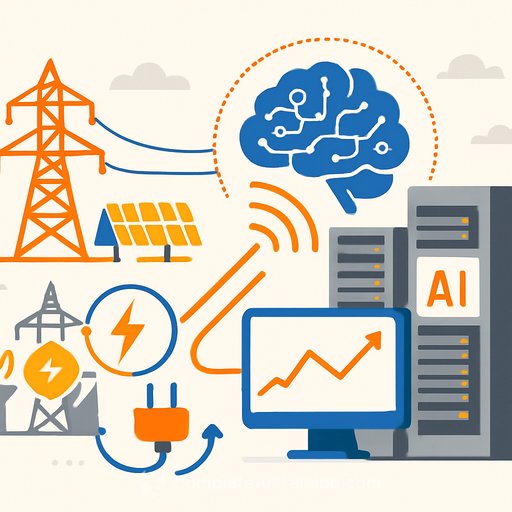Bridging the Gap: How Smart Demand Management Can Forestall the AI Energy Crisis
The AI Power Bottleneck
AI's demand for electricity is growing faster than the power grid can accommodate, creating a significant bottleneck. The grid’s development cycles span decades, but AI requires rapid scaling that outpaces these timelines.
Curtailment Unlocks Untapped Power
The US power grid holds between 76 and 126 gigawatts of slack capacity. This idle power could be accessed if companies can pause or reduce their demand during short peak strain periods lasting a few hours.
A Perfect Match
AI workloads are uniquely suited to take advantage of curtailment. Unlike traditional cloud services that demand constant uptime, AI operations can pause and resume, making it easier to leverage this untapped grid capacity without sacrificing performance.
From Grid Burden to Grid Asset
This flexibility could transform AI datacenters from a grid strain into a valuable asset. Acting as “shock absorbers,” they can boost grid efficiency, monetize idle infrastructure, and enhance responsiveness, supporting greater integration of intermittent renewable sources like solar and wind.
Crisis Becomes an Opportunity
The surge in AI power demand could add the equivalent load of 75 million American homes (around 100 GW) by 2030. This challenges a power sector accustomed to nearly flat demand growth for two decades and long lead times for new infrastructure.
But AI workloads can pause and load-balance better than traditional datacenter tasks. This allows participation in curtailment programs—running at full capacity most of the year, but scaling back during grid stress. Since the grid is built for peak demand, most capacity sits idle part of the time, waiting for moments like the hottest summer afternoons.
For AI companies, sacrificing a small fraction of uptime is a fair trade-off for accessing gigawatts of existing power. Instead of overwhelming the grid, AI datacenters could unlock this stranded capacity and improve grid utilization.
Datacenter Uptime Assumptions Drove an AI Power Crisis
Traditional datacenter design values near-perfect uptime. Tier 3 datacenters aim for 99.982% uptime, while Tier 4 aims for 99.995%, with costs rising steeply for small gains in reliability. This focus on reliability made sense when datacenters formed a minor part of power demand.
But these stringent uptime requirements now contribute to the AI power challenge, as such rigid infrastructure is expensive and slow to expand.
Speed and Scale Trump Perfect Uptime in AI Infrastructure
AI companies prioritize speed and scale over near-perfect uptime. Getting power quickly enables faster model deployment, which accelerates data collection and model improvement in a virtuous cycle. This speed advantage outweighs the benefits of marginal uptime gains.
Current AI services often operate at uptime levels similar to the lowest tier of traditional datacenters, reflecting this shift in priorities.
The Flexibility Revolution: How AI Enables Curtailment
AI workloads can pause and resume without losing progress thanks to techniques like checkpointing during training. Inference tasks are also more tolerant of latency compared to traditional web applications, allowing load balancing across regions with available power.
This tolerance means AI tasks can be rerouted across continents without hurting user experience, unlike traditional applications where milliseconds matter greatly. Emerging AI agents performing multi-step tasks over minutes further increase this flexibility, enabling a "set it and forget it" approach.
A Bridge Solution: Slack Capacity on the US Grid
AI’s workload flexibility allows two key advances:
- Pausing workloads to reduce demand during grid peak times
- Load balancing demand geographically to areas with available capacity
The US grid is designed for peak demand, leaving substantial unused capacity during most hours. Utilizing this slack via curtailment programs could rapidly add 76 to 126 GW of effective capacity without new infrastructure.
According to analysis from Duke University’s Nicholas Institute, curtailment can add approximately 10% to the nation’s effective capacity with minimal impact on uptime. Typical curtailment events last 1.7 to 2.5 hours and still maintain at least half capacity during those times.
This approach could bridge the gap while new power infrastructure projects, which often take over a decade, are completed.
The Upside: Quick Power, Lower Cost, Stronger Grid
Curtailment offers faster deployment than building new power plants or dedicated infrastructure, which face long manufacturing and interconnection delays. This speed is critical given grid interconnection backlogs now exceeding ten years in many cases.
The economic benefits are significant. Unlocking 100 GW of capacity at $1,500 per kW equates to leveraging $150 billion worth of existing infrastructure. Many power plants have large blocks of capacity available via curtailment programs, representing valuable assets.
Improving grid utilization benefits everyone. Most infrastructure runs at just over 50% capacity, meaning fixed costs are spread thinly. Flexible AI workloads can increase utilization, lowering costs for utilities and ratepayers while enhancing revenue for investors.
This reframes AI’s energy impact from a crisis to an opportunity to make the grid more efficient and resilient.
Conclusion: Two Revolutions Collide
The common narrative warns of AI overwhelming the electrical grid. The reality could be the opposite: AI datacenters can become essential grid partners by tapping into existing capacity through demand flexibility.
Speed remains the key competitive advantage in AI, and power limitations cannot become the bottleneck that hands leadership to other countries expanding their infrastructure more rapidly.
At the same time, the US power system is shifting toward intermittent renewable sources, requiring demand-side adaptation. AI workloads’ flexibility aligns perfectly with this new energy landscape, supporting a bidirectional optimization between supply and demand.
With annual AI infrastructure investments exceeding $300 billion, the financial incentive to implement curtailment at scale is stronger than ever. This approach represents a practical pathway to accelerate AI deployment while supporting grid evolution and clean energy integration.
For more insights into AI infrastructure and training, explore resources at Complete AI Training.
Your membership also unlocks:






